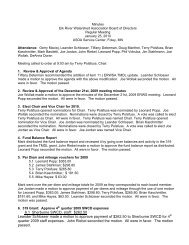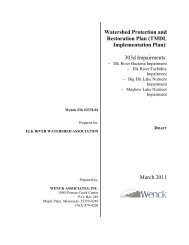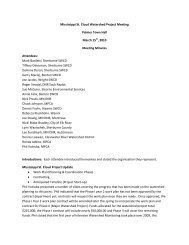- 2 -Figure 2. Black leaf spot of American elm. Diseased spotsare raised, rough, and scablike (IL N<strong>at</strong>. Hist. Survey).Figure 3. White mold or downy spot of black walnut.Yellowish blotches on <strong>the</strong> upper leaf surface; glisteningfrosty growth on lower leaf surface (Purdue University).Cause and Disease CycleMany leaf spot diseases are caused by fungi th<strong>at</strong> overwinter infallen leaves. O<strong>the</strong>r fungi overwinter in infected buds, fruits,twigs, and branch cankers. In most cases a fungus th<strong>at</strong> causes acertain leaf spot <strong>at</strong>tacks only one species of tree; a few may<strong>at</strong>tack several species.From early spring into summer, microscopic spores are producedin tremendous numbers on <strong>the</strong> surface of <strong>the</strong> leaves or in specksizedpycnidia, acervuli, and peri<strong>the</strong>cia embedded in <strong>the</strong> diseasedleaf tissue. The spores are spread primarily by air currents,splashing rains, and insects to newly emerging leaves ofsusceptible trees where, in <strong>the</strong> presence of free w<strong>at</strong>er, <strong>the</strong> sporesgermin<strong>at</strong>e and penetr<strong>at</strong>e, and infection begins. Depending on <strong>the</strong>fungus, <strong>the</strong>re may be one or several cycles (gener<strong>at</strong>ions) of <strong>the</strong>p<strong>at</strong>hogen in one growing season.Although infected leaves and o<strong>the</strong>r plant tissue harboring <strong>the</strong>fungus usually persist from one growing season to <strong>the</strong> next, <strong>the</strong>cool, rainy periods in early to mid-spring are often not longenough for <strong>the</strong> fungus to grow, multiply, and infect new leaves.Consequently, <strong>the</strong> presence and severity of leaf spot diseases arevariable from year to year. <strong>Leaf</strong> spots are most likely to developwhen <strong>the</strong>re are extended periods of cool, moist we<strong>at</strong>her duringApril, May, and June when <strong>the</strong> new leaf growth is expanding.Species of fungi th<strong>at</strong> most commonly cause leaf spot diseasesbelong to <strong>the</strong> following genera: Alternaria, Ascochyta,Cercospora, Ciborinia, Coccomyces, Coniothyrium, Coryneum,Cristulariella, Cylindrosporium, Discochora (Guignardia),Figure 3. <strong>Leaf</strong> blotch of horse chestnut.Reddish brown areas; narrow yellowishmargins form on leaflets.Figure 4. White mold or downy spot of blackwalnut. Yellowish blotches on <strong>the</strong> upper leafsurface; glistening frosty growth on lower leafsurface (Purdue Univ).Elsinoe (anamorph: Sphaceloma), Entomosporium (telemorph: Diplocarpon), Gloeosporium (varioussynonyms), Gnomonia (Apiognomonia, Stegophora), Hendersonia, Marssonina, Microstroma,
- 3 -Monochaetia, Mycosphaerella, Phyllosticta, Physalospora, Rhytisma, Septogloeum, Septoria, Taphrina,Tubakia (synonym: Actinopelte), and Venturia. These genera include over 1,000 species of fungi capableof producing leaf spots on various woody plants.Table 1 lists <strong>the</strong> most common genera of fungi th<strong>at</strong> cause leaf spot diseases, <strong>the</strong> host trees <strong>at</strong>tacked, and<strong>the</strong> general symptoms of each disease.ControlProtective control measures are not generally warranted for most leaf spots. Although <strong>the</strong> fallen leavesare often collected and <strong>the</strong>n composted, burned, or hauled away with <strong>the</strong> trash, <strong>the</strong>re is little evidence toshow th<strong>at</strong> <strong>the</strong>se practices will significantly reduce infection <strong>the</strong> following spring and summer.1. In early spring, properly fertilize trees th<strong>at</strong> have been severely defoli<strong>at</strong>ed in previous years.Surface applic<strong>at</strong>ions of ammonium nitr<strong>at</strong>e fertilizer <strong>at</strong> <strong>the</strong> r<strong>at</strong>e of 18 pounds per 1,000 square feetor urea <strong>at</strong> 13 pounds per 1,000 square feet are recommended. Apply <strong>the</strong> fertilizer with a cyclonespreader. Fertiliz<strong>at</strong>ion will help to stimul<strong>at</strong>e vigorous growth, as will w<strong>at</strong>ering thoroughly (soilshould be moist to a 12-inch depth) <strong>at</strong> weekly intervals during extended dry periods.2. Prune trees regularly to thin out dense crowns. Remove weak, diseased, insect-infested, or deadwood and crossing or rubbing branches. Proper pruning will promote air movement, speed dryingof <strong>the</strong> leaves, and help to stimul<strong>at</strong>e vigorous growth.3. In most years, <strong>the</strong> we<strong>at</strong>her is not favorable for severe disease development and, in most cases, leafspot diseases are not especially harmful. Therefore, for <strong>the</strong> control of most leaf spot diseases,protective fungicidal sprays are generally not recommended unless <strong>the</strong> health of <strong>the</strong> tree is indanger. However, <strong>the</strong>re are a few common leaf spot diseases th<strong>at</strong> can be controlled by usingfungicidal sprays. In <strong>the</strong>se cases, two or three applic<strong>at</strong>ions are needed <strong>at</strong> 7- to 21-day intervals,usually as soon as <strong>the</strong> buds start to open and <strong>the</strong> leaves begin to expand, and long before <strong>the</strong>leaves are visibly infected. Spraying fungicides after <strong>the</strong> disease appears will reduce secondaryinfections but will not elimin<strong>at</strong>e infections th<strong>at</strong> have already occurred. Additional sprays may benecessary following prolonged rainy periods.For detailed spray schedules, read Illinois Homeowners Guide to <strong>Pest</strong> <strong>Management</strong>. The containerlabel will tell you whe<strong>the</strong>r a fungicide can be used on a specific tree. When applying any diseasecontrolchemical, carefully follow all directions and precautions as printed on <strong>the</strong> container label.Too much fungicide can injure trees, especially under certain we<strong>at</strong>her conditions.4. Some species and varieties (cultivars) of shade and ornamental trees are resistant to some leaf spotdiseases. The following list names species th<strong>at</strong> are resistant to various diseases: buckeye andhorse chestnut to leaf blotch (Discochora or Guignardia aesculi); crabapple to scab (Venturiainaequalis); willow and poplar to one or more rusts (Melampsora species); elm to black spot oranthracnose (Stegophora or Gnomonia ulmea); red, shingle, and bur oaks to anthracnose(Apiognomonia quercina, anamorph: Discula quercina); London plane tree to anthracnose(Apiognomonia veneta, anamorph: Discula pl<strong>at</strong>ani); and hawthorn to Entomosporium leaf spotor blight (Diplocarpon mespili, anamorph: Entomosporium mespili)







